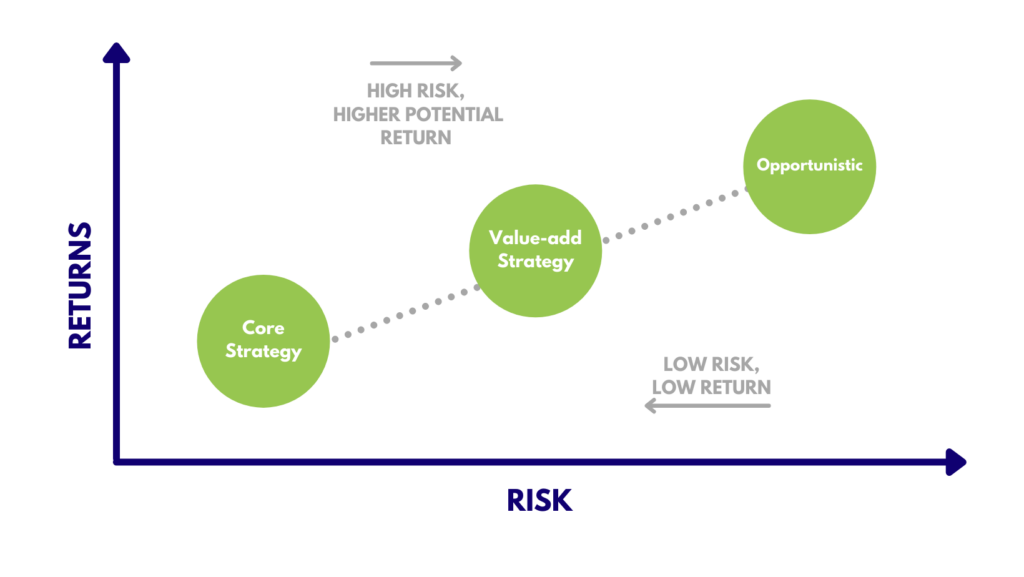The key to achieving optimal allocation for any investor’s portfolio is to find a productive balance between risk and return. Accredited investors benefit from a wide range of investment options in the alternative space, which plays an important role in meeting the criteria of proper asset allocation. But before you jump into details, charts or percentages, it is important to familiarize yourself with some of the concepts of optimal asset allocation and consider how private real estate can help you meet your personal investment goals.
Remember, it’s important to consult with your personal tax advisor, money manager, or attorney as needed.
First things first: What’s your investment objective?
Your investment objective answered the question, “what are you looking to accomplish with your investments?” When we talk about risk vs. return, the general rule of thumb is the higher the risk level, the higher the potential returns can be. There are strategies that align well with an aggressive investment objective, which have a potential for a higher return because they carry more risk. On the other hand, a conservative approach takes on less risk but can provide steady returns over time, even if lower than a higher risk strategy. The graphic below provides a high-level overview of this concept. Ideally, you’d like to have investments in each “bucket” of investments. We’ll talk more about why in a few.

Are you looking to preserve your capital? Are you interested in long-term compounding? Are you seeking to generate consistent income from your investments to finance your lifestyle? These are the questions you must ask yourself prior to developing your asset allocation strategy.
Time Horizon
How quickly will you need access to your money? If soon (say, 1 to 5 years for example), it’s important to know that real estate, in general, is an illiquid investment and may not be ideal if you anticipate needing speedy access to funds invested.
Typically, if you are an older investor looking to generate cash flow from your portfolio, more conservative strategies may be beneficial. If you are younger, and have a longer timeframe to work with, investments with higher ceiling, but lower volatility may help you meet a long-term compounding objective.
Consistent Returns through Low Volatility and Low Correlation
The foundation of a strong asset allocation strategy is to target assets historically demonstrating both low volatility and consistent returns.
General investment advice would suggest putting money into several public market asset classes like bonds, large cap equities, REITs, or international equity. However, this strategy is not entirely diversified because it would be highly correlated to movement in public markets.
For example: While REITs may be invested in assets considered to be “alternative investments”, they are still publicly traded and are highly correlated to the public markets.
In contrast, private real estate investing comes with a low correlation to the market, allowing it to generate positive returns even if the public markets are in a downturn.
Diversification – Or, how to invest in multiple asset classes at once
Diversification is the idea of allocating your money into a variety of investment vehicles to mitigate risk. It is otherwise known quite affectionately in the industry as “not putting your eggs in one basket.” The idea behind this is that you, as the investor, are not overexposed. Let’s take the example above: If you were 100% invested in the public markets and the market plunged, you’d lose everything you had invested. But if you invested 50% of that into the private market, you’d have some level of stability during volatile times.
When it comes to private real estate, an often overlooked factor of asset allocation in your investment portfolio is how you diversify into multiple asset classes. This goes beyond simply investing in several different properties. Your strategy should include geographical diversification (multiple metro areas), asset type diversification (office, retail, multifamily, industrial) even property class allocation (Class A, B, C).
Again, by diversifying across asset class, you “widen your net” of potential returns and mitigate the risk that may be associated with an area, asset type or vintage.
Surrounding yourself with a team of investment professionals, like financial advisors or CPAs, can provide additional advice and insight into constructing a portfolio meeting both your investment objectives and the circumstances of your tax situation. There are a myriad of factors involved in constructing an investor’s portfolio. The concepts detailed above provide an ideal starting point to determine what best meets your needs.
Interested in investing with MLG Capital? With us, you can invest in private real estate with confidence. Start your journey today.
Jade Hendricks is an Investor Relations Associate at MLG Capital, with a background in Wealth Management and Wealth Education. She’s a financial literacy advocate, gym enthusiast and lover of all things coffee. If you’re an accredited investor, invest with us.



